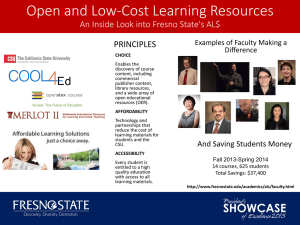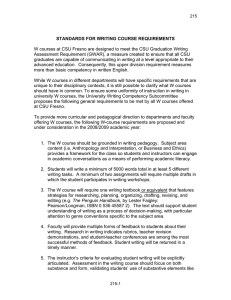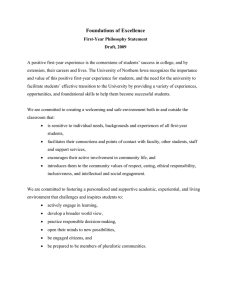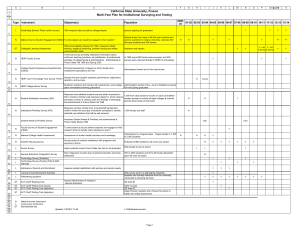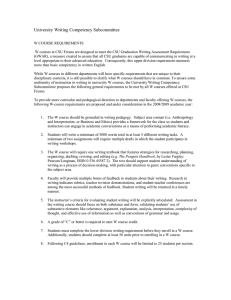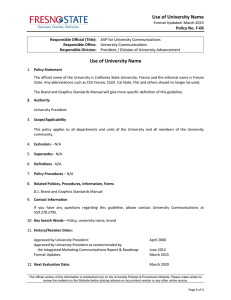Results from the Spring 2011 National Survey of Student Engagement
advertisement
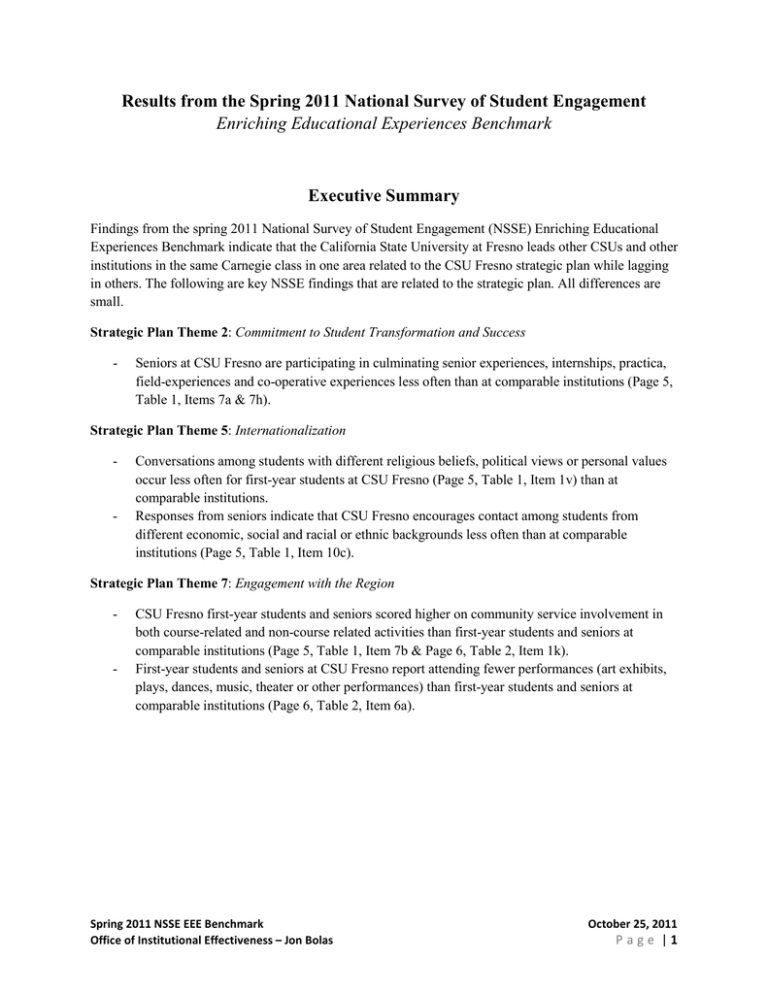
Results from the Spring 2011 National Survey of Student Engagement Enriching Educational Experiences Benchmark Executive Summary Findings from the spring 2011 National Survey of Student Engagement (NSSE) Enriching Educational Experiences Benchmark indicate that the California State University at Fresno leads other CSUs and other institutions in the same Carnegie class in one area related to the CSU Fresno strategic plan while lagging in others. The following are key NSSE findings that are related to the strategic plan. All differences are small. Strategic Plan Theme 2: Commitment to Student Transformation and Success - Seniors at CSU Fresno are participating in culminating senior experiences, internships, practica, field-experiences and co-operative experiences less often than at comparable institutions (Page 5, Table 1, Items 7a & 7h). Strategic Plan Theme 5: Internationalization - - Conversations among students with different religious beliefs, political views or personal values occur less often for first-year students at CSU Fresno (Page 5, Table 1, Item 1v) than at comparable institutions. Responses from seniors indicate that CSU Fresno encourages contact among students from different economic, social and racial or ethnic backgrounds less often than at comparable institutions (Page 5, Table 1, Item 10c). Strategic Plan Theme 7: Engagement with the Region - - CSU Fresno first-year students and seniors scored higher on community service involvement in both course-related and non-course related activities than first-year students and seniors at comparable institutions (Page 5, Table 1, Item 7b & Page 6, Table 2, Item 1k). First-year students and seniors at CSU Fresno report attending fewer performances (art exhibits, plays, dances, music, theater or other performances) than first-year students and seniors at comparable institutions (Page 6, Table 2, Item 6a). Spring 2011 NSSE EEE Benchmark Office of Institutional Effectiveness – Jon Bolas October 25, 2011 Page |1 About the National Survey of Student Engagement (NSSE): In spring 2011, the California State University at Fresno administered the National Survey of Student Engagement (NSSE) to first-year students and seniors. This is the fifth time since 2001 that CSU Fresno has participated in the NSSE. The NSSE is used to measure the amount of effort students put into their studies and how universities deploy their resources. Response rates for the survey were 27% for first-year students and 32% for seniors, with sampling errors of 3.1% and 1.9% respectively. Detailed information about the survey can be found at: nsse.iub.edu/html/about.cfm. Once the survey is complete, CSU Fresno receives a final report detailing the results. To help interpret how CSU Fresno performed, the report offers comparisons to other institutions sharing the same Carnegie classification. For information on Carnegie classifications, visit classifications.carnegiefoundation.org. For 2011, the NSSE report also provides comparisons to other CSU campuses. The final report also scores CSU Fresno on five benchmarks. Benchmarks are created by combining several related survey items into a single score. The benchmarks are: (1) Level of Academic Challenge, (2) Active and Collaborative Learning, (3) Student-Faculty Interaction, (4) Supportive Campus Environment, and (5) Enriching Educational Experiences (EEE). Information about the construction of NSSE benchmarks can be found at: nsse.iub.edu/_/?cid=403. The EEE benchmark relates to several key areas in the CSU Fresno strategic plan: (1) Commitment to Student Transformation and Success, (2) Internationalization, and (3) Engagement with the Region. Therefore, the EEE benchmark will be the focus of the rest of this report. How to Read the Tables: Table 1 on Page 5 shows the mean scores for the EEE benchmark and the individual survey items that are used to create the benchmark. Table 2 on Page 6 shows the mean scores for additional survey items logically related to the EEE benchmark to help better understand the perceptions of students. For ease of comparison, percentages are also included that show the frequency of responses for each survey item. The NSSE instructions for interpreting the findings are as follows. Two statistics are offered to help interpret the performance of CSU Fresno relative to comparison institutions: (1) “Items with mean differences that are larger than expected by chance alone are noted with one, two, or three asterisks, referring to three significance levels (p<.05, p<.01, p<.001). The smaller the significance level, the smaller the likelihood that the difference is due to chance. Statistical significance does not guarantee the result is substantive or important.”1 (2) To understand the practical meaning of the results, effect sizes are given. “An effect size of .2 is often considered small, .5 moderate, and .8 large. A positive sign indicates that your institution’s mean was greater, thus showing an affirmative result for your institution. A negative sign indicates the institution lags behind the comparison group, suggesting that the student behavior or institutional practice represented by the item may warrant attention.”1 Overall EEE Benchmark Findings: - As shown in Table 1, seniors at CSU Fresno have a mean score of 36.6 compared to 38.4 for seniors at other institutions in the same Carnegie class. With a significance level of p<.001, the difference is not likely due to chance. An effect size of -.10 means the difference is negative but small, indicating CSU Fresno slightly lags other institutions in the same Carnegie class for the EEE benchmark but the difference may not be large enough to suggest a need for change. Spring 2011 NSSE EEE Benchmark Office of Institutional Effectiveness – Jon Bolas October 25, 2011 Page |2 The EEE benchmark may or may not warrant attention, which is why the following section looks at the individual survey items in order to get a clearer view of how the university is performing in this area. Findings for Individual EEE Benchmark Survey Items: In the following sections, EEE benchmark survey items are grouped into topic areas to better understand the strengths and weaknesses students perceive. In addition to the survey items that make up the EEE benchmark, survey items that are logically related to the topics are included in Table 2. Internship, Practicum or Field-Experience Participation / Culminating Senior Experience: These survey items focus on the opportunities students have to apply the skills they learn during their college career in either a professional environment or culminating project. The most relevant student group to look at for this topic is seniors, since the survey items look at whether a student completed these activities or not and these programs are primarily designed for seniors. - Seniors at CSU Fresno are participating in culminating senior experiences, internships, practica, field-experiences and co-operative experiences less often compared to other CSUs and other institutions in the same Carnegie class (Table 1, Items 7a & 7h). The effect size for Item 7h, culminating experiences, is -.36, which suggests this is an area that warrants discussion and consideration if CSU Fresno wants to align itself with comparable institutions. Interactions with Diverse Groups on Campus: - - For first-year students at CSU Fresno, fewer responded that they often or very often have serious conversations with others who are very different from themselves in terms of their religious beliefs, political opinions or personal values compared to first-year students at comparable institutions. Forty-eight percent of first-year students at CSU Fresno compared to 54% at other CSUs and 52% at other institutions in the same Carnegie class responded with often or very often (Table 1, Item 1v). Fewer seniors at CSU Fresno responded that CSU Fresno often or very often encourages contact among students from different economic, social and racial or ethnic backgrounds when compared to seniors at comparable institutions. Forty-eight percent of CSU Fresno seniors compared to 53% of seniors at other CSUs and 53% of seniors at other institutions in the same Carnegie class state they feel their university often or very often encourages contact (Table 1, Item 10c). These findings indicate that interactions among groups with different religious beliefs, political views or personal values occur less often for first-year students at CSU Fresno compared to first-year students at comparable institutions. From the perspective of seniors, CSU Fresno is not encouraging contact among students from different economic, social, and racial or ethnic backgrounds as often as comparable institutions. University-Related Activities Outside of Class: - First-year students and seniors at CSU Fresno attended artistic performances less often, when compared to CSUs and other institutions in the same Carnegie class (Page 6, Table 2, Item 6a). Spring 2011 NSSE EEE Benchmark Office of Institutional Effectiveness – Jon Bolas October 25, 2011 Page |3 - First-year students at CSU Fresno worked with classmates outside of class to prepare class assignments as often as at comparable institutions (Page 6, Table 2, Item 1h). Seniors worked with classmates outside of class to prepare class assignments less often when compared to other CSUs and other institutions in the same Carnegie class (Page 6, Table 2, Item 1h). These findings indicate that: (1) CSU Fresno students are not participating in the arts as often compared to students at comparable institutions, and (2) Later in their college careers, CSU Fresno students work with classmates outside of class to prepare class assignments less often than at comparable institutions. Community Service Participation: - - Overall, first-year students and seniors at CSU Fresno are more active in community service or volunteer work than at other CSUs and other institutions in the same Carnegie class (Table 1, Item 7b & Table 2, Item 1k). First-year students are more actively involved in community projects as part of a course than first-year students at other CSUs and other institutions in the same Carnegie class. Item 1k in Table 2 shows 23% of first-year students participated in a community-based project as part of a regular course compared to 12% at other CSUs and 14% at other institutions in the same Carnegie class. These findings indicate that CSU Fresno connects students to community service/volunteer activities early in students’ college careers and students continue to be involved as seniors. Conclusion: The NSSE has identified areas where CSU Fresno is different from comparable institutions, but the differences are small. Consequently, change may or may not be warranted, but the issues should be discussed. These issues are: The extent of culminating experiences, participation in university-related activities outside of class, and interactions with diverse groups on campus. CSU Fresno leads comparable institutions in students’ community service and community-based project participation, and the effect sizes are small to moderate. References 1 National Survey of Student Engagement. (2011). Institutional Report 2011. Bloomington, IN: Indiana University Center for Postsecondary Research. Spring 2011 NSSE EEE Benchmark Office of Institutional Effectiveness – Jon Bolas October 25, 2011 Page |4 Table 1: EEE Benchmark and Individual Survey Items Comprising the Benchmark Fresno State Benchmark: Enriching Educational Experiences Class Mean First-Year 26.5 Senior 36.6 % CSUs Carnegie Class Effect Size Mean 26.3 .02 26.5 37.0 -.02 38.4 Mean Sig % Sig % Effect Size .00 *** -.10 Individual Survey Items That Comprise the Benchmark Response Options: In your experience at your institution during the current school year, about how often have you done each of the following? 1=Never, 2=Sometimes, 3=Often, 4=Very often. Percentage shown is for those responding with "3" or "4". Used an electronic medium (listserv, First-Year 2.62 54% 2.67 55% -.04 2.66 55% -.03 chat group, Internet, instant messaging, etc.) to discuss or complete an Senior 2.88 63% 2.90 64% -.02 2.89 64% -.01 assignment Had serious conversations with students 2.52 50% 2.71 *** 58% -.19 2.57 51% -.05 First-Year 1u. of a different race or ethnicity than your Senior 2.80 60% 2.83 61% -.03 2.67 *** 54% .13 own Had serious conversations with students First-Year 2.50 48% 2.65 *** 54% -.16 2.62 ** 52% -.12 who are very different from you in terms 1v. of their religious beliefs, political Senior 2.71 56% 2.72 56% -.01 2.69 55% .02 opinions, or personal values Response Options: Which of the following have you done or do you plan to do before you graduate from your institution? (Recoded: 0=Have not decided, Do not plan to do, Plan to do; 1=Done. Thus, the mean is the proportion responding "Done" among all valid respondents.) Percentage shown is for those responding with "1". 1l. 7a. 7b. 7c. 7e. 7f. 7g. 7h. Practicum, internship, field experience, co-op experience, or clinical assignment First-Year .05 5% .06 Senior .39 39% .42 6% -.03 .06 * 42% -.05 .47 6% -.04 *** 47% -.15 First-Year .42 42% .32 *** 32% .22 .36 ** 36% .13 Senior .61 61% .50 *** 50% .23 .56 *** 56% .12 First-Year .19 19% .16 16% .08 .16 16% .08 Senior .28 28% .21 21% .16 .26 26% .06 First-Year .14 14% .15 15% -.02 .16 16% -.05 Senior .33 33% .33 First-Year .04 4% .02 Senior .09 9% .08 Independent study or self-designed major First-Year .06 6% .03 Senior .12 12% Culminating senior experience (capstone course, senior project or thesis, comprehensive exam, etc.) First-Year .02 Senior* .14 Community service or volunteer work Participate in a learning community or some other formal program where groups of students take two or more classes together *** * Foreign language coursework 33% .00 .34 34% -.02 2% .15 .03 3% .05 8% .02 .11 11% -.07 3% .16 .04 4% .07 .11 11% .02 .15 15% -.07 2% .02 2% .01 .02 2% -.02 14% .30 30% -.36 .30 30% -.36 ** Study abroad ** *** ** ** *** Response Options: About how many hours do you spend in a typical 7-day week doing each of the following? 1=0 hrs/wk, 2=1-5 hrs/wk, 3=6-10 hrs/wk, 4=11-15 hrs/wk, 5=16-20 hrs/wk, 6=21-25 hrs/wk, 7=26-30 hrs/wk, 8=More than 30 hrs/wk Percentage shown is for those responding with 1 or more hours. Participating in co-curricular activities First-Year 1.89 43% 1.93 45% -.03 2.11 *** 56% (organizations, campus publications, student government, fraternity or 9d. sorority, intercollegiate or intramural Senior 1.98 48% 1.88 ** 43% .07 1.99 48% sports, etc.) Response Options: To what extent does your institution emphasize each of the following? 1=Very little, 2=Some, 3=Quite a bit, 4=Very much. Percentage shown is for those responding with "3" or "4". Encouraging contact among students First-Year 2.78 61% 2.79 63% -.01 2.74 61% 10c. from different economic, social, and Senior 2.47 48% 2.60 *** 53% -.13 2.59 *** 53% racial or ethnic backgrounds -.15 -.01 .04 -.12 * = p<.05, ** = p<.01, *** = p<.001 Spring 2011 NSSE EEE Benchmark Office of Institutional Effectiveness – Jon Bolas October 25, 2011 Page |5 Table 2: Survey Items Related to EEE Benchmark CSU Fresno CSUs Carnegie Class Effect Effect Additional Survey Items: Expanding on Enriching Mean % Mean Sig % Mean Sig % Class Size Size Educational Experiences Benchmark Response Options: In your experience at your institution during the current school year, about how often have you done each of the following? 1=Never, 2=Sometimes, 3=Often, 4=Very often. Percentage shown is for those responding with "Often" or "Very Often". Percentage shown is for those answering "3" or "4". Worked with classmates outside of class First-Year 2.42 46% 2.46 45% -.05 2.41 45% .01 1h. to prepare class assignments Senior 2.73 57% 2.87 *** 64% -.15 2.78 * 61% -.05 Tutored or taught other students First-Year 1.62 14% 1.67 15% -.06 1.63 14% -.01 1j. (paid or voluntary) Senior 1.87 21% 1.84 21% .03 1.82 * 20% .05 Participated in a community-based project First-Year 1.77 23% 1.52 *** 12% .31 1.55 *** 14% .27 1k. (e.g. service learning) as part of a regular course Senior 1.89 22% 1.72 *** 19% .19 1.74 *** 19% .16 1o. Talked about career plans with a faculty member or advisor First-Year 2.18 32% 2.03 *** 27% .16 2.16 32% .02 Senior 2.31 36% 2.26 * 36% .06 2.40 *** 42% -.08 Discussed ideas from your readings or First-Year 1.85 22% 1.84 21% .01 1.84 21% .00 1p. classes with faculty members outside of class Senior 1.96 23% 2.01 * 25% -.06 2.09 *** 28% -.14 Worked with faculty members on First-Year 1.62 17% 1.56 14% .07 1.62 16% .00 activities other than coursework 1s. (committees, orientation, student life activities, etc.) Senior 1.77 21% 1.73 20% .04 1.83 * 23% -.05 Discussed ideas from your readings or First-Year 2.72 57% 2.74 59% -.02 2.73 59% -.02 classes with others outside of class 1t. (students, family members, co-workers, etc.) Senior 2.89 65% 2.89 66% .00 2.89 66% .00 Response Options: During the current school year, about how often have you done each of the following? 1=Never, 2=Sometimes, 3=Often, 4=Very often. Percentage shown is for those answering "3" or "4". First-Year 1.89 20% 2.03 *** 25% -.15 2.10 *** 29% -.22 Attended an art exhibit, play, dance, 6a. music, theater or other performance Senior 1.91 19% 1.95 * 22% -.05 1.96 * 22% -.06 6b. Exercised or participated in physical fitness activities First-Year 2.66 53% 2.66 Senior 2.69 53% 2.60 *** 54% .00 2.79 51% .08 2.67 ** 60% -.12 53% .02 Response Options: Which of the following have you done or do you plan to do before you graduate from your institution? (Recoded: 0=Have not decided, Do not plan to do, Plan to do; 1=Done. Thus, the mean is the proportion responding "Done" among all valid respondents.) Percentage shown is for those responding with "1". Work on a research project with a faculty First-Year .06 6% .04 4% .07 .05 member outside of course or program requirements Senior .15 15% .14 14% .03 .16 Response Options: To what extent has your experience at this institution contributed to your knowledge, skills, and personal development in the following areas? 1=Very little, 2=Some, 3=Quite a bit, 4=Very much. Percentage shown is for those answering "3" or "4". 7d. 11l. Understanding people of other racial and ethnic backgrounds First-Year 2.77 63% 2.83 Senior 2.71 59% 2.78 * 5% .05 16% -.02 66% -.06 2.71 59% .07 62% -.07 2.70 58% .01 * = p<.05, ** = p<.01, *** = p<.001 Spring 2011 NSSE EEE Benchmark Office of Institutional Effectiveness – Jon Bolas October 25, 2011 Page |6
